Detailed Comparison of Vietnamese and Japanese Cooking Styles
VerifiedAdded on 2022/11/16
|6
|1096
|316
Report
AI Summary
This report provides a comparative analysis of Vietnamese and Japanese cooking styles. It begins by examining the key differences in ingredients, such as the preference for fish sauce versus soy sauce and the types of fish used. The report then explores the influences on each cuisine, including French and Chinese culinary traditions, and how both Vietnamese and Japanese food have impacted global cuisine, with examples like sushi and pho. Finally, it discusses possible future trends, such as the globalization of these cuisines and the emergence of Vietnamese and Japanese fast food in Western countries. The report references several academic sources to support its claims, providing a comprehensive overview of the topic.
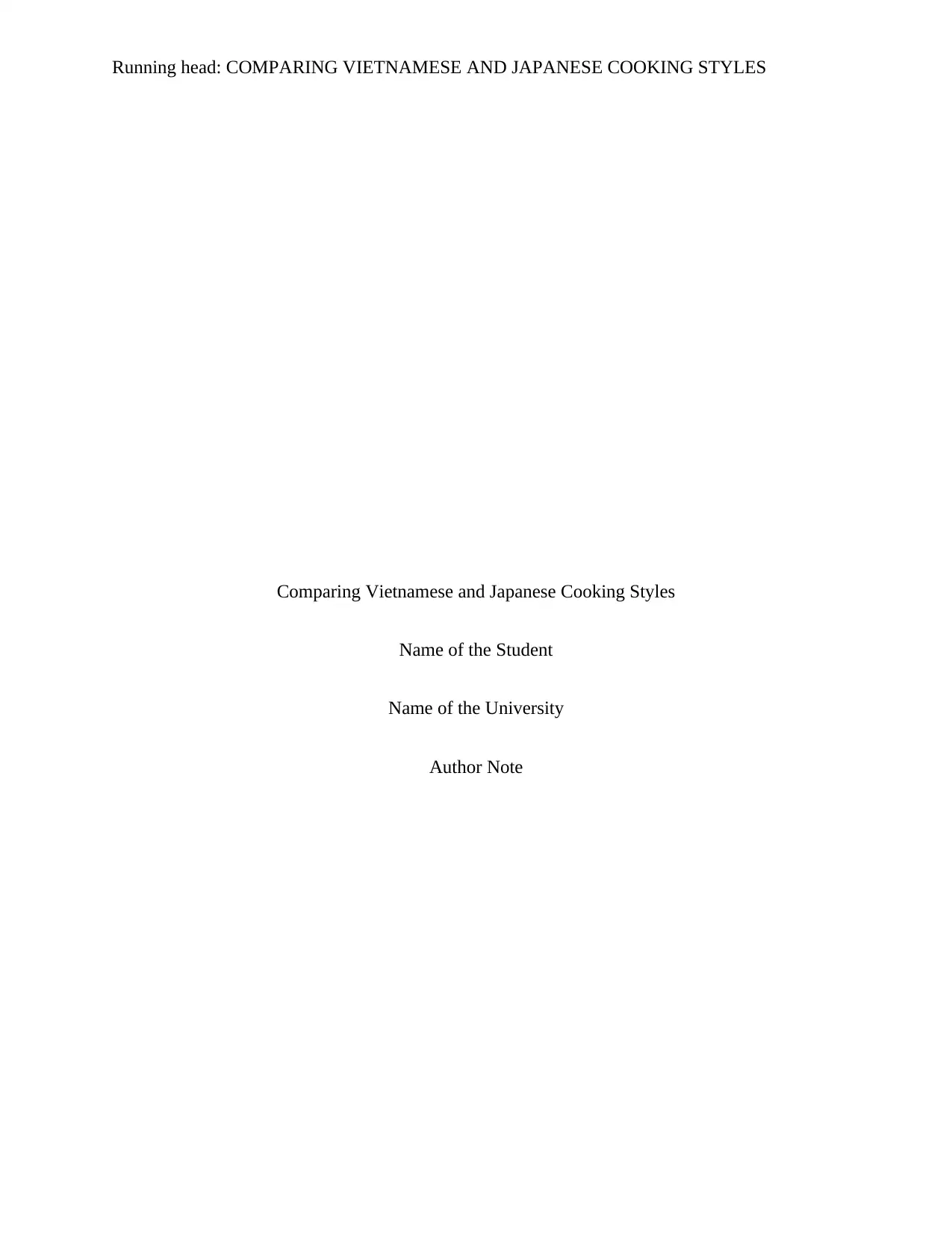
Running head: COMPARING VIETNAMESE AND JAPANESE COOKING STYLES
Comparing Vietnamese and Japanese Cooking Styles
Name of the Student
Name of the University
Author Note
Comparing Vietnamese and Japanese Cooking Styles
Name of the Student
Name of the University
Author Note
Paraphrase This Document
Need a fresh take? Get an instant paraphrase of this document with our AI Paraphraser
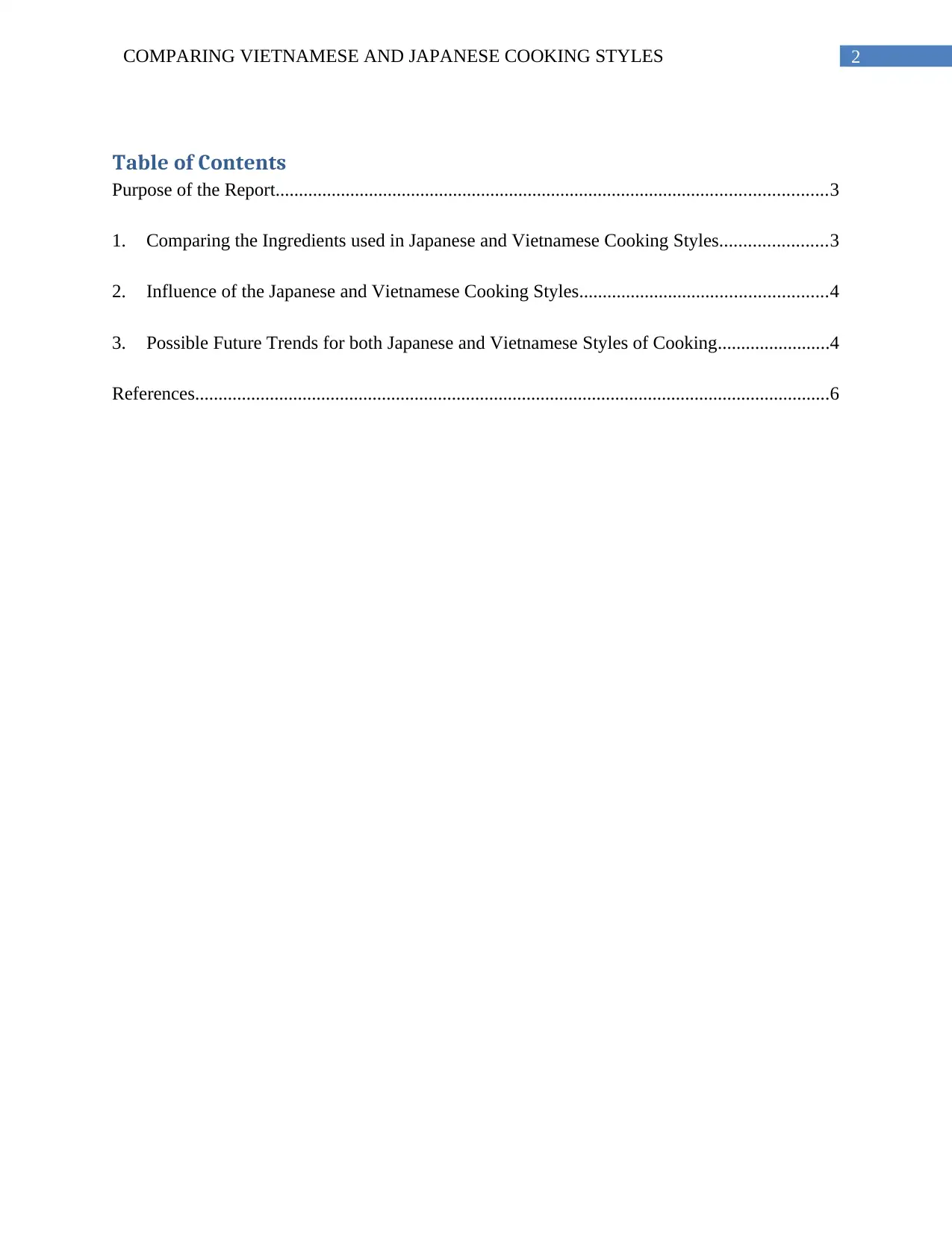
2COMPARING VIETNAMESE AND JAPANESE COOKING STYLES
Table of Contents
Purpose of the Report......................................................................................................................3
1. Comparing the Ingredients used in Japanese and Vietnamese Cooking Styles.......................3
2. Influence of the Japanese and Vietnamese Cooking Styles.....................................................4
3. Possible Future Trends for both Japanese and Vietnamese Styles of Cooking........................4
References........................................................................................................................................6
Table of Contents
Purpose of the Report......................................................................................................................3
1. Comparing the Ingredients used in Japanese and Vietnamese Cooking Styles.......................3
2. Influence of the Japanese and Vietnamese Cooking Styles.....................................................4
3. Possible Future Trends for both Japanese and Vietnamese Styles of Cooking........................4
References........................................................................................................................................6
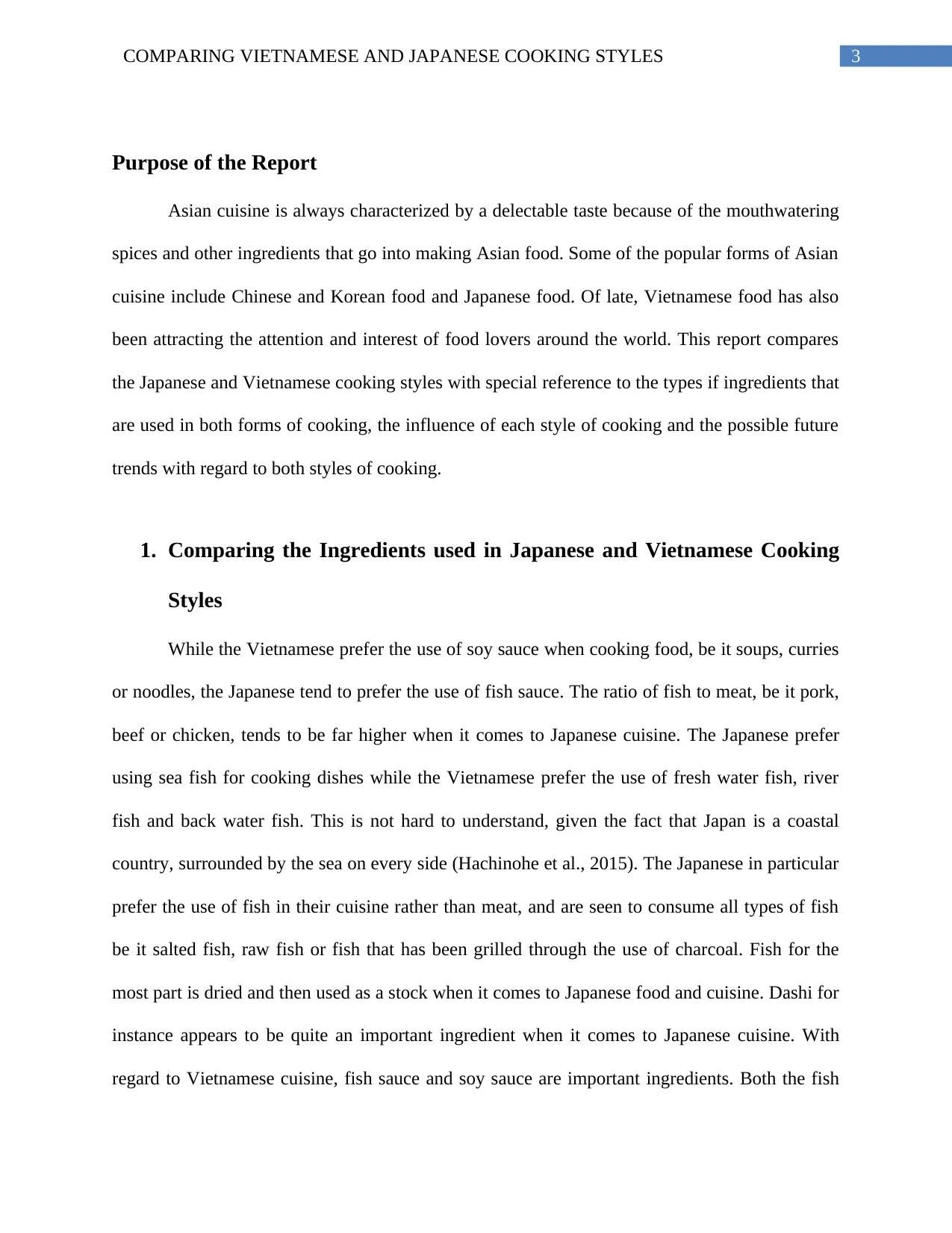
3COMPARING VIETNAMESE AND JAPANESE COOKING STYLES
Purpose of the Report
Asian cuisine is always characterized by a delectable taste because of the mouthwatering
spices and other ingredients that go into making Asian food. Some of the popular forms of Asian
cuisine include Chinese and Korean food and Japanese food. Of late, Vietnamese food has also
been attracting the attention and interest of food lovers around the world. This report compares
the Japanese and Vietnamese cooking styles with special reference to the types if ingredients that
are used in both forms of cooking, the influence of each style of cooking and the possible future
trends with regard to both styles of cooking.
1. Comparing the Ingredients used in Japanese and Vietnamese Cooking
Styles
While the Vietnamese prefer the use of soy sauce when cooking food, be it soups, curries
or noodles, the Japanese tend to prefer the use of fish sauce. The ratio of fish to meat, be it pork,
beef or chicken, tends to be far higher when it comes to Japanese cuisine. The Japanese prefer
using sea fish for cooking dishes while the Vietnamese prefer the use of fresh water fish, river
fish and back water fish. This is not hard to understand, given the fact that Japan is a coastal
country, surrounded by the sea on every side (Hachinohe et al., 2015). The Japanese in particular
prefer the use of fish in their cuisine rather than meat, and are seen to consume all types of fish
be it salted fish, raw fish or fish that has been grilled through the use of charcoal. Fish for the
most part is dried and then used as a stock when it comes to Japanese food and cuisine. Dashi for
instance appears to be quite an important ingredient when it comes to Japanese cuisine. With
regard to Vietnamese cuisine, fish sauce and soy sauce are important ingredients. Both the fish
Purpose of the Report
Asian cuisine is always characterized by a delectable taste because of the mouthwatering
spices and other ingredients that go into making Asian food. Some of the popular forms of Asian
cuisine include Chinese and Korean food and Japanese food. Of late, Vietnamese food has also
been attracting the attention and interest of food lovers around the world. This report compares
the Japanese and Vietnamese cooking styles with special reference to the types if ingredients that
are used in both forms of cooking, the influence of each style of cooking and the possible future
trends with regard to both styles of cooking.
1. Comparing the Ingredients used in Japanese and Vietnamese Cooking
Styles
While the Vietnamese prefer the use of soy sauce when cooking food, be it soups, curries
or noodles, the Japanese tend to prefer the use of fish sauce. The ratio of fish to meat, be it pork,
beef or chicken, tends to be far higher when it comes to Japanese cuisine. The Japanese prefer
using sea fish for cooking dishes while the Vietnamese prefer the use of fresh water fish, river
fish and back water fish. This is not hard to understand, given the fact that Japan is a coastal
country, surrounded by the sea on every side (Hachinohe et al., 2015). The Japanese in particular
prefer the use of fish in their cuisine rather than meat, and are seen to consume all types of fish
be it salted fish, raw fish or fish that has been grilled through the use of charcoal. Fish for the
most part is dried and then used as a stock when it comes to Japanese food and cuisine. Dashi for
instance appears to be quite an important ingredient when it comes to Japanese cuisine. With
regard to Vietnamese cuisine, fish sauce and soy sauce are important ingredients. Both the fish
⊘ This is a preview!⊘
Do you want full access?
Subscribe today to unlock all pages.

Trusted by 1+ million students worldwide
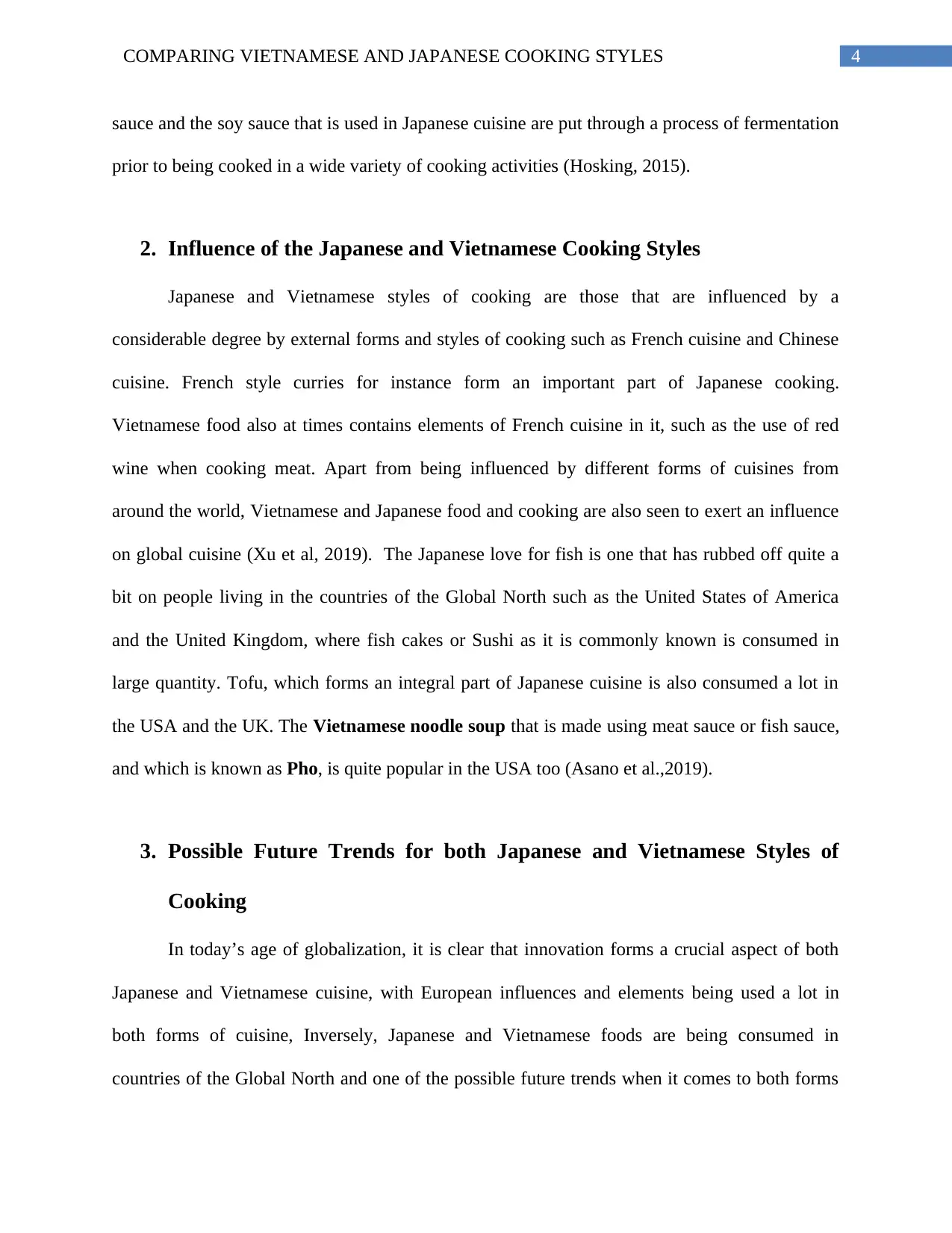
4COMPARING VIETNAMESE AND JAPANESE COOKING STYLES
sauce and the soy sauce that is used in Japanese cuisine are put through a process of fermentation
prior to being cooked in a wide variety of cooking activities (Hosking, 2015).
2. Influence of the Japanese and Vietnamese Cooking Styles
Japanese and Vietnamese styles of cooking are those that are influenced by a
considerable degree by external forms and styles of cooking such as French cuisine and Chinese
cuisine. French style curries for instance form an important part of Japanese cooking.
Vietnamese food also at times contains elements of French cuisine in it, such as the use of red
wine when cooking meat. Apart from being influenced by different forms of cuisines from
around the world, Vietnamese and Japanese food and cooking are also seen to exert an influence
on global cuisine (Xu et al, 2019). The Japanese love for fish is one that has rubbed off quite a
bit on people living in the countries of the Global North such as the United States of America
and the United Kingdom, where fish cakes or Sushi as it is commonly known is consumed in
large quantity. Tofu, which forms an integral part of Japanese cuisine is also consumed a lot in
the USA and the UK. The Vietnamese noodle soup that is made using meat sauce or fish sauce,
and which is known as Pho, is quite popular in the USA too (Asano et al.,2019).
3. Possible Future Trends for both Japanese and Vietnamese Styles of
Cooking
In today’s age of globalization, it is clear that innovation forms a crucial aspect of both
Japanese and Vietnamese cuisine, with European influences and elements being used a lot in
both forms of cuisine, Inversely, Japanese and Vietnamese foods are being consumed in
countries of the Global North and one of the possible future trends when it comes to both forms
sauce and the soy sauce that is used in Japanese cuisine are put through a process of fermentation
prior to being cooked in a wide variety of cooking activities (Hosking, 2015).
2. Influence of the Japanese and Vietnamese Cooking Styles
Japanese and Vietnamese styles of cooking are those that are influenced by a
considerable degree by external forms and styles of cooking such as French cuisine and Chinese
cuisine. French style curries for instance form an important part of Japanese cooking.
Vietnamese food also at times contains elements of French cuisine in it, such as the use of red
wine when cooking meat. Apart from being influenced by different forms of cuisines from
around the world, Vietnamese and Japanese food and cooking are also seen to exert an influence
on global cuisine (Xu et al, 2019). The Japanese love for fish is one that has rubbed off quite a
bit on people living in the countries of the Global North such as the United States of America
and the United Kingdom, where fish cakes or Sushi as it is commonly known is consumed in
large quantity. Tofu, which forms an integral part of Japanese cuisine is also consumed a lot in
the USA and the UK. The Vietnamese noodle soup that is made using meat sauce or fish sauce,
and which is known as Pho, is quite popular in the USA too (Asano et al.,2019).
3. Possible Future Trends for both Japanese and Vietnamese Styles of
Cooking
In today’s age of globalization, it is clear that innovation forms a crucial aspect of both
Japanese and Vietnamese cuisine, with European influences and elements being used a lot in
both forms of cuisine, Inversely, Japanese and Vietnamese foods are being consumed in
countries of the Global North and one of the possible future trends when it comes to both forms
Paraphrase This Document
Need a fresh take? Get an instant paraphrase of this document with our AI Paraphraser
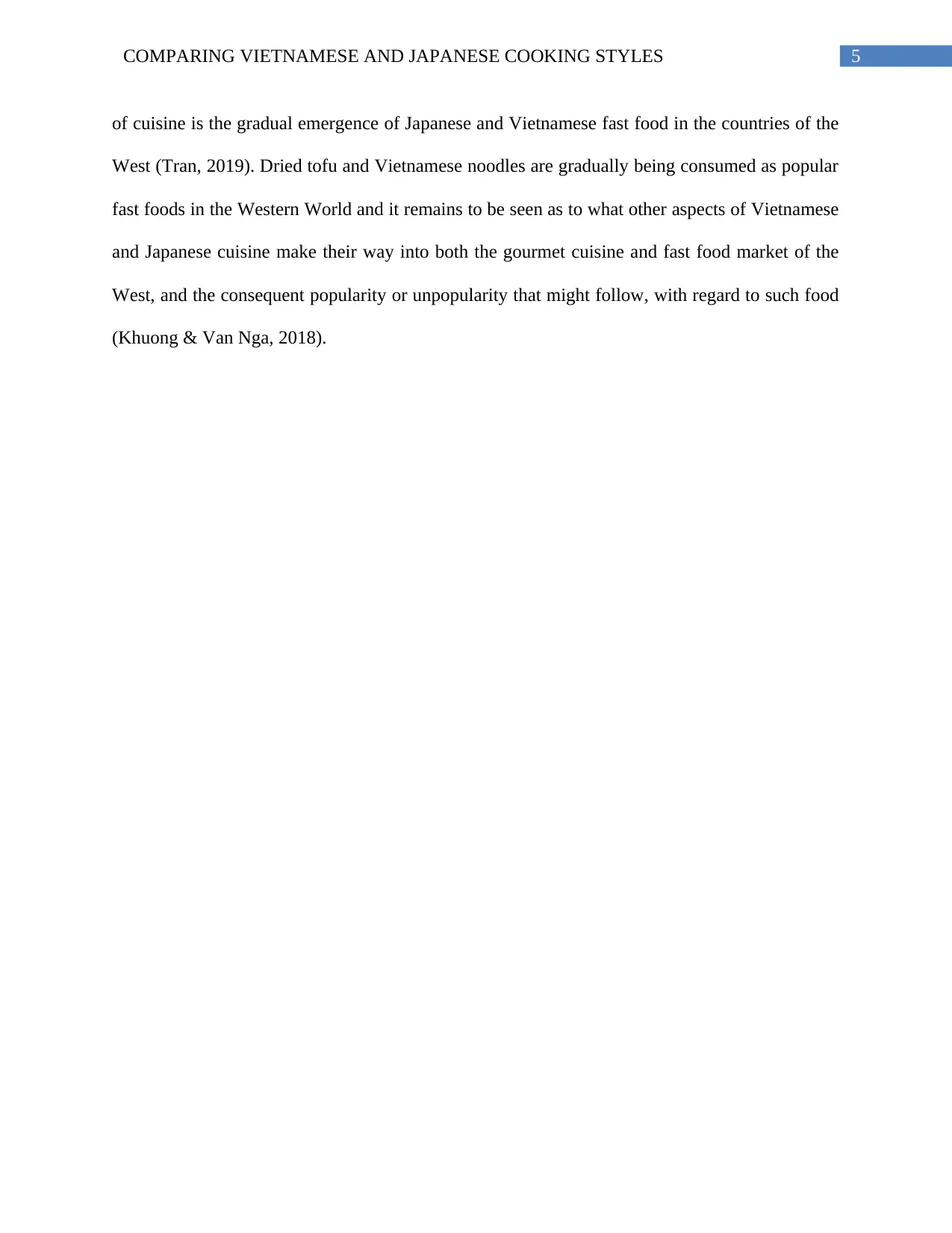
5COMPARING VIETNAMESE AND JAPANESE COOKING STYLES
of cuisine is the gradual emergence of Japanese and Vietnamese fast food in the countries of the
West (Tran, 2019). Dried tofu and Vietnamese noodles are gradually being consumed as popular
fast foods in the Western World and it remains to be seen as to what other aspects of Vietnamese
and Japanese cuisine make their way into both the gourmet cuisine and fast food market of the
West, and the consequent popularity or unpopularity that might follow, with regard to such food
(Khuong & Van Nga, 2018).
of cuisine is the gradual emergence of Japanese and Vietnamese fast food in the countries of the
West (Tran, 2019). Dried tofu and Vietnamese noodles are gradually being consumed as popular
fast foods in the Western World and it remains to be seen as to what other aspects of Vietnamese
and Japanese cuisine make their way into both the gourmet cuisine and fast food market of the
West, and the consequent popularity or unpopularity that might follow, with regard to such food
(Khuong & Van Nga, 2018).
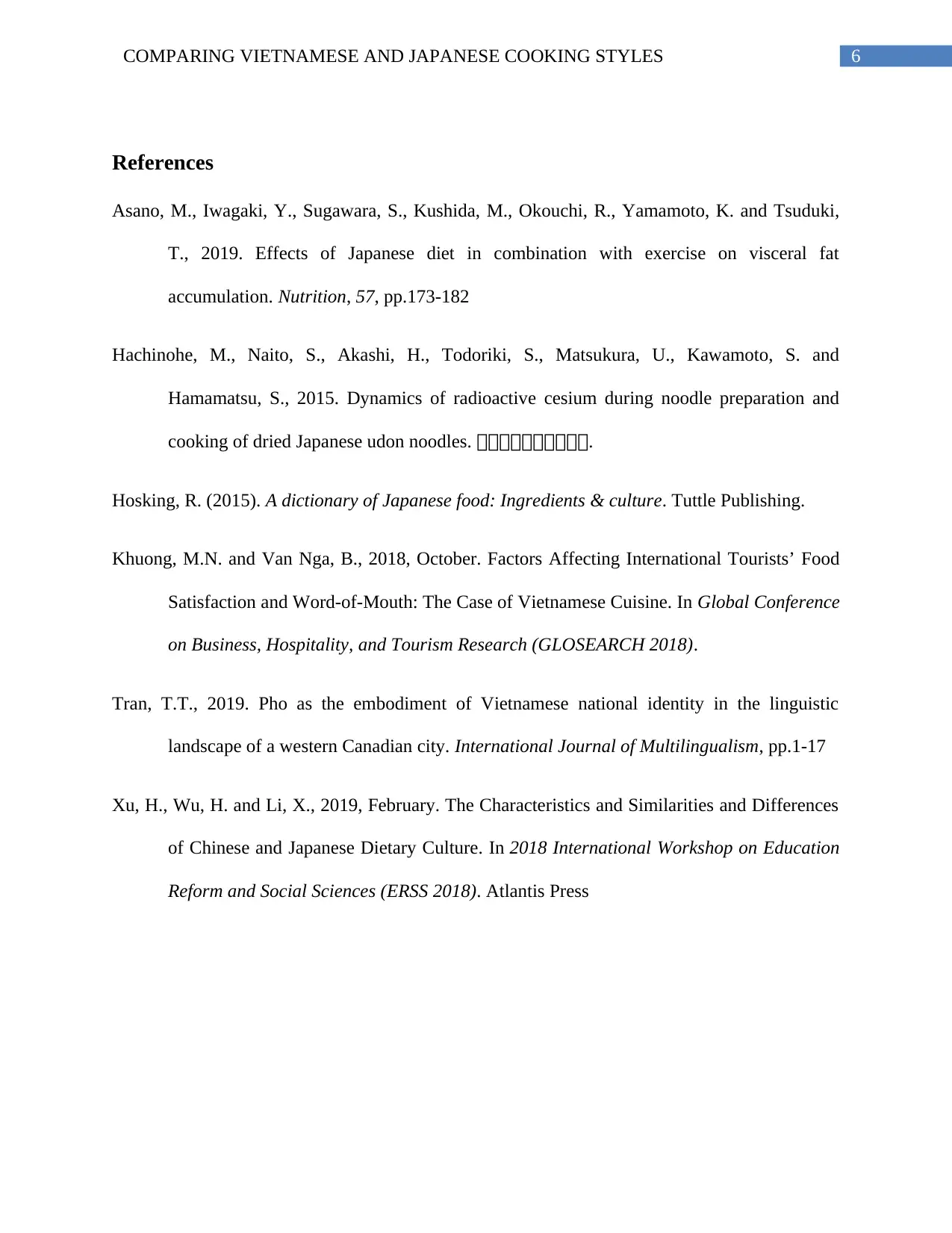
6COMPARING VIETNAMESE AND JAPANESE COOKING STYLES
References
Asano, M., Iwagaki, Y., Sugawara, S., Kushida, M., Okouchi, R., Yamamoto, K. and Tsuduki,
T., 2019. Effects of Japanese diet in combination with exercise on visceral fat
accumulation. Nutrition, 57, pp.173-182
Hachinohe, M., Naito, S., Akashi, H., Todoriki, S., Matsukura, U., Kawamoto, S. and
Hamamatsu, S., 2015. Dynamics of radioactive cesium during noodle preparation and
cooking of dried Japanese udon noodles. 日日日日日日日日日日.
Hosking, R. (2015). A dictionary of Japanese food: Ingredients & culture. Tuttle Publishing.
Khuong, M.N. and Van Nga, B., 2018, October. Factors Affecting International Tourists’ Food
Satisfaction and Word-of-Mouth: The Case of Vietnamese Cuisine. In Global Conference
on Business, Hospitality, and Tourism Research (GLOSEARCH 2018).
Tran, T.T., 2019. Pho as the embodiment of Vietnamese national identity in the linguistic
landscape of a western Canadian city. International Journal of Multilingualism, pp.1-17
Xu, H., Wu, H. and Li, X., 2019, February. The Characteristics and Similarities and Differences
of Chinese and Japanese Dietary Culture. In 2018 International Workshop on Education
Reform and Social Sciences (ERSS 2018). Atlantis Press
References
Asano, M., Iwagaki, Y., Sugawara, S., Kushida, M., Okouchi, R., Yamamoto, K. and Tsuduki,
T., 2019. Effects of Japanese diet in combination with exercise on visceral fat
accumulation. Nutrition, 57, pp.173-182
Hachinohe, M., Naito, S., Akashi, H., Todoriki, S., Matsukura, U., Kawamoto, S. and
Hamamatsu, S., 2015. Dynamics of radioactive cesium during noodle preparation and
cooking of dried Japanese udon noodles. 日日日日日日日日日日.
Hosking, R. (2015). A dictionary of Japanese food: Ingredients & culture. Tuttle Publishing.
Khuong, M.N. and Van Nga, B., 2018, October. Factors Affecting International Tourists’ Food
Satisfaction and Word-of-Mouth: The Case of Vietnamese Cuisine. In Global Conference
on Business, Hospitality, and Tourism Research (GLOSEARCH 2018).
Tran, T.T., 2019. Pho as the embodiment of Vietnamese national identity in the linguistic
landscape of a western Canadian city. International Journal of Multilingualism, pp.1-17
Xu, H., Wu, H. and Li, X., 2019, February. The Characteristics and Similarities and Differences
of Chinese and Japanese Dietary Culture. In 2018 International Workshop on Education
Reform and Social Sciences (ERSS 2018). Atlantis Press
⊘ This is a preview!⊘
Do you want full access?
Subscribe today to unlock all pages.

Trusted by 1+ million students worldwide
1 out of 6
Related Documents
Your All-in-One AI-Powered Toolkit for Academic Success.
+13062052269
info@desklib.com
Available 24*7 on WhatsApp / Email
![[object Object]](/_next/static/media/star-bottom.7253800d.svg)
Unlock your academic potential
Copyright © 2020–2025 A2Z Services. All Rights Reserved. Developed and managed by ZUCOL.





